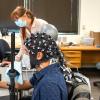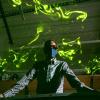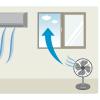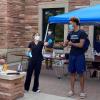Research
 Graduate students Kathryn Mains and Kyle Schlafmann have earned fellowships in the National Defense Science and Engineering Graduate Fellowship Program, a prestigious, national security-focused initiative.
Graduate students Kathryn Mains and Kyle Schlafmann have earned fellowships in the National Defense Science and Engineering Graduate Fellowship Program, a prestigious, national security-focused initiative. Take a seat in the classroom of tomorrow—where intelligent computers work side-by-side with groups of students to support their engagement in meaningful and productive learning experiences designed by their teachers.
Take a seat in the classroom of tomorrow—where intelligent computers work side-by-side with groups of students to support their engagement in meaningful and productive learning experiences designed by their teachers. The Department of Chemical and Biological Engineering welcomes five new faculty members to its ranks this year, with three professors beginning in the fall and two having started this past spring.
The Department of Chemical and Biological Engineering welcomes five new faculty members to its ranks this year, with three professors beginning in the fall and two having started this past spring. A gift of $2 million from the Mortenson family caps an impressive year of growth for the Mortenson Center in Global Engineering, including new federal and nonprofit funding totaling more than $11 million and significant research findings.
A gift of $2 million from the Mortenson family caps an impressive year of growth for the Mortenson Center in Global Engineering, including new federal and nonprofit funding totaling more than $11 million and significant research findings. Associate Professor Michael Shirts is the recipient of the 2020 Computational Molecular Science & Engineering Forum Impact Award.
Associate Professor Michael Shirts is the recipient of the 2020 Computational Molecular Science & Engineering Forum Impact Award. CU Boulder's John Crimaldi will lead a groundbreaking new international research network dubbed Odor2Action. The work is aimed at understanding how animals use information from odors in their environment to guide behavior, with far-ranging implications for our understanding of the human brain.
CU Boulder's John Crimaldi will lead a groundbreaking new international research network dubbed Odor2Action. The work is aimed at understanding how animals use information from odors in their environment to guide behavior, with far-ranging implications for our understanding of the human brain. Good ventilation can reduce the risk of catching coronavirus. Environmental engineer Shelly Miller explains how to know if enough outside air is getting into a room and what to do if ventilation is bad.
Good ventilation can reduce the risk of catching coronavirus. Environmental engineer Shelly Miller explains how to know if enough outside air is getting into a room and what to do if ventilation is bad. It's the second BRAIN Initiative grant for the multi-institutional group, which includes faculty from electrical, computer and energy engineering; civil, environmental and architectural engineering; and mechanical engineering.
It's the second BRAIN Initiative grant for the multi-institutional group, which includes faculty from electrical, computer and energy engineering; civil, environmental and architectural engineering; and mechanical engineering. CU Boulder is ramping up its ability to conduct COVID-19 monitoring analyses by enlisting volunteer graduate students and postdocs across campus, including several from the Department of Chemical and Biological Engineering.
CU Boulder is ramping up its ability to conduct COVID-19 monitoring analyses by enlisting volunteer graduate students and postdocs across campus, including several from the Department of Chemical and Biological Engineering. CU Boulder will play a major role in a new center focused on developing infrastructure and systems that facilitate the widespread adoption of electric vehicles.
CU Boulder will play a major role in a new center focused on developing infrastructure and systems that facilitate the widespread adoption of electric vehicles.

